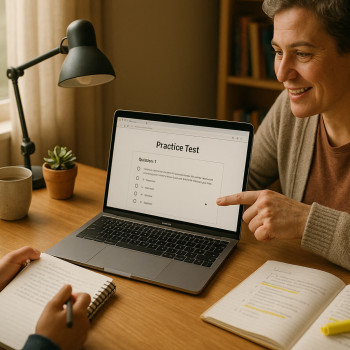Should I Retake the Digital SAT? A Short, Honest Answer
Short answer: sometimes. Longer answer: it depends on what you hope to accomplish, how much you can improve with focused work, and how each college on your list treats multiple scores. For many students—especially those aiming for competitive colleges—a well-planned retake can make a meaningful difference. But not every retake helps, and an unnecessary one can waste time, money, and focus in the senior year. This guide walks you through the real effects of retaking the SAT, backed by how colleges typically use scores, plus practical steps to decide, prepare, and get the most from another test attempt.

What Colleges Actually Do with Multiple SAT Scores
Colleges are the ones who decide how they use SAT scores. There are three common approaches you’ll run into:
- Superscoring — the college takes the highest section scores from different test dates and combines them into the best possible composite.
- Score-choice or selective reporting — students can choose which test dates to send, though some schools require all scores.
- All-scores policy — the college requires every test date’s scores and considers them all.
Most selective colleges today will superscore or focus on your best results, but there are important exceptions. That’s why checking each school’s policy is essential. If you’re applying to top-tier institutions, research their particular approach early—this will shape whether a retake is strategically useful.
What superscoring means for a retake
Suppose your first test had a strong Math score but a weaker Reading & Writing, and your second test flips that pattern. With superscoring, the admissions office may combine your best Math from test A and your best Evidence-Based Reading & Writing from test B to create a higher composite. That’s a clear, tangible benefit of retaking.
When a Retake Is Likely to Help
Not all retakes are created equal. Consider a retake when at least one of the following is true:
- You didn’t reach your realistic target for the schools you’re applying to.
- Your test experience was disrupted (illness, bad testing conditions) and your score doesn’t reflect your ability.
- Your practice tests and official score reports show clear, fixable weaknesses (timing, specific content areas, or question types you missed repeatedly).
- You have time and a concrete plan to improve before application deadlines.
If you check those boxes, a retake—especially with focused prep—can boost your chances at competitive colleges.
When to skip a retake
Don’t retake just because you ‘could.’ Consider passing on another attempt if:
- Your score is already within or above the middle 50% range for your target schools.
- Your GPA, essays, recommendations, and extracurriculars form the stronger parts of your profile and test scores are optional or unlikely to change admission decisions.
- You’re too close to application deadlines to make meaningful improvement.
How Much Improvement Is Realistic — and How Much Matters?
Many students gain points on a second or third SAT, but the size of that gain varies. A focused study plan can often yield modest but important improvements: think 20–80 points, sometimes more for students who address specific weaknesses. But what matters most is where those points move you relative to your target colleges’ reported score ranges.
| Scenario | Typical Score Change | Why It Matters |
|---|---|---|
| Minor improvements with targeted practice | 10–40 points | Can strengthen scholarship prospects and improve fit within a college’s middle 50%. |
| Substantial gains after structured tutoring | 50–150+ points | Can shift admissions chances at selective colleges and make a student more competitive for merit aid. |
| No focused preparation, rushed retake | ±0–10 points | Unlikely to change outcomes; may waste time and energy. |
Use these ranges as rules-of-thumb, not guarantees. Improvement is a function of time invested, quality of practice, and how well the student targets weaknesses.
Timing Your Retake: When to Test Again
Timing should be driven by college deadlines and by how long it takes to make meaningful improvement. A common and effective rhythm looks like this:
- First full test: spring of junior year — gives an initial baseline and time to improve.
- Second test: fall of senior year — allows improvements to be reflected on early action/decision applications.
- Third test: limited cases in late fall or early winter if more improvement is reasonably possible and deadlines allow.
Two important calendar checks: know each college’s application deadline (regular vs. early), and the SAT registration and score release schedule for the Digital SAT. Aim to have reliable scores uploaded before deadlines. If you’re applying early, plan your retake so scores arrive in time for early decision or early action notifications.
Practical timeline for improvements
If you have 6–12 weeks to prepare, you can typically make measurable progress with a disciplined plan: diagnostic test, targeted practice, timed sections, full-length practice in the digital format, and a final review. If you have fewer than 4 weeks, gains are possible but usually smaller unless your weaknesses are narrow and fixable.
How to Make a Retake Worth It: A Concrete Plan
Don’t schedule another test because you ‘feel like it.’ Make the retake count with a plan that addresses three things: assessment, deliberate practice, and performance rehearsal.
Step 1 — Diagnostic and Analysis
- Break your previous score down by section and question type.
- Identify patterns: timing errors, specific content gaps, or question types you miss under pressure.
- Set a realistic target: 20–40 points is meaningful for many schools; 100+ might be needed to shift chances at the most selective colleges.
Step 2 — Targeted Practice
- Focus on the 20% of errors that cause 80% of lost points. For example, if geometry questions are tripping you up, prioritize that content.
- Use official Digital SAT practice tools and full-length practice in the digital format to build stamina and familiarity with the test interface.
- Practice under timed conditions and simulate test-day logistics.
Step 3 — Performance Rehearsal
Take at least two full-length, timed digital practice tests in the final 2–3 weeks before your retake. Treat them as real tests—same blocks, same breaks, same environment when possible. Review wrong answers carefully; don’t just tally them.
How personalized tutoring magnifies gains
Working with an expert tutor can compress months of progress into weeks by focusing on exactly the skills that matter and providing accountability. Personalized tutoring—1-on-1 guidance, tailored study plans, subject-matter expertise, and timely feedback—helps many students move from plateau to progress faster. Programs that combine expert tutoring with data-driven insights and targeted practice can also help you prioritize the right weaknesses and prepare in the digital test format.
How to Send Scores: Practical Choices and Considerations
When you’ve taken the SAT multiple times you can usually choose which test dates to send. But since colleges set their own rules, you’ll need to confirm whether they require all scores or allow score choice. If a college superscores, sending multiple dates can highlight your best sections. If a college requires all scores, a lower earlier score will be visible—but admissions officers usually view scores in context of growth, coursework, and other application elements.
Smart score-sending strategies
- If a college superscores, sending both your higher math date and your higher reading date can work to your advantage.
- If a college requires all scores, focus on improving your later test so the trend shows upward progress rather than relying on a single exceptional day.
- Use score choice only after verifying the college policy and after confirming deadlines for free score sends tied to registration.
Beyond Scores: How Retakes Fit into a Holistic Application
Top colleges review applications holistically. A higher SAT can help, but it’s one of several parts of your package: GPA, coursework rigor, essays, recommendations, extracurricular leadership, and demonstrated interest all matter. Sometimes a retake moves the needle most for scholarship eligibility rather than admission per se. In other cases, an upward trend—steady improvement between test dates—strengthens an application’s narrative.
When a score increase matters most
- When a small score bump moves you into or above the middle 50% range for a target school.
- When you’re competing for merit scholarships tied to specific score thresholds.
- When your application narrative benefits from an upward trend that shows academic growth and resilience.
Real-World Example: Two Students, Two Paths
Example 1 — Maya: First test 1250, second test 1370. Maya focused on targeted tutoring for her math weaknesses and timed practice. Her improved composite pushed her into the higher end of the middle 50% for a few selective schools and helped her secure a merit scholarship at one of her top choices.
Example 2 — Jordan: First test 1480, second test 1510. Jordan’s scores were already within reach for his target colleges. He chose to spend senior fall refining essays and preparing interviews instead of retaking again. His application remained competitive without another test date because he used his time to strengthen other parts of his profile.
Both students made thoughtful decisions tied to personal goals and timelines—there’s no one-size-fits-all answer.
How to Choose a Tutor or Program for a Retake
If you decide a retake is worth it, choose help that is:
- Personalized: you need a plan built around your diagnostic, not a generic curriculum.
- Experienced with the digital format: Digital SAT strategies differ from paper in pacing and interface familiarity.
- Results-focused: look for structured goals, measurable milestones, and accountability.
For many families, a blend of expert human tutoring and data-driven insights is the fastest route to improvement. Sparkl’s personalized tutoring, for example, offers 1-on-1 guidance, tailored study plans, expert tutors, and AI-driven insights that help prioritize weaknesses and accelerate gains—useful when time is limited and stakes are high.
Common Myths About Retaking the SAT
- Myth: Colleges punish students who retake the SAT. Fact: Colleges don’t penalize retakes; they consider scores according to their policies.
- Myth: Every retake will boost my score. Fact: Without a plan, a retake may not change much. Improvement requires targeted effort.
- Myth: One huge jump is required to matter. Fact: Small, strategic gains can matter if they shift your position relative to a college’s score range or scholarship thresholds.
Checklist: Should You Retake the SAT?
- Do I have time before application deadlines to prepare properly?
- Does the retake have a reasonable chance to move my score into a new band for my target schools?
- Can I commit to a plan (diagnostic, targeted practice, full-length rehearsals) or get help (tutoring) to ensure improvement?
- Have I checked each college’s score policy (superscore, require all scores, or score choice)?
If you answered yes to most of these, a retake is likely worth it.
Final Thoughts — Make the Retake Strategic, Not Emotional
Retaking the SAT is a strategic decision. It’s not a measure of worth, and it’s not the entire story of your college application. Approach it like any other important project: diagnose honestly, plan deliberately, use high-quality practice, and get individualized help when needed. For students targeting top colleges, every point can matter—so approach the retake with purpose, not panic.

Quick Resources for Students and Parents (What to Do Next)
1) Check each college’s SAT policy early. 2) Take a fresh diagnostic in the Digital SAT format. 3) Build a focused study plan with measurable milestones. 4) Consider one-on-one tutoring if you need structured progress—especially when deadlines are tight. Personalized programs that combine expert tutoring and AI-driven insights can shorten the path to a better score by highlighting the highest-impact practice.
Final example of a 10-week retake plan
- Weeks 1–2: Diagnostic test, detailed score breakdown, set target.
- Weeks 3–6: Intensive content work (math concepts, grammar, reading strategies) with weekly timed sections.
- Weeks 7–8: Full-length digital practice tests and targeted review of missed questions.
- Weeks 9–10: Light review, confidence-building timed practice, and test-day logistics rehearsal.
In Short
Retaking the SAT can be a powerful lever in the college application process if it’s done for the right reasons and with a well-constructed plan. Understand each college’s policies, set realistic targets, focus your practice on the highest-leverage improvements, and consider personalized tutoring when you need efficient, directed progress. A thoughtful retake—paired with strong academics, essays, and activities—can open doors at top colleges and sometimes unlock scholarship opportunities too.
If you’d like, try this next: run a diagnostic, list three weak areas, and set a single, clear numeric goal for your next test. From there, decide whether to self-study or bring in focused help. Either way, plan intentionally—and remember: incremental, well-targeted progress wins more often than frantic repetition.
Need help creating a plan?
If you want help turning a diagnostic into an actionable plan, a short series of 1-on-1 tutoring sessions with a specialist can provide clarity and momentum. Consider a program that couples expert tutors with actionable, data-driven steps to reach your target efficiently—so your next test is your best test.














No Comments
Leave a comment Cancel